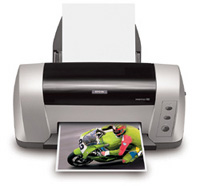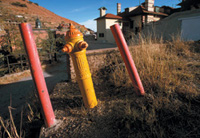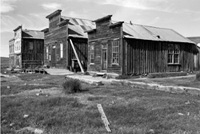Epson Stylus C82
A Sensible And Affordable Choice For Photographers
With digital cameras and scanners getting both better and more affordable the ability to print photo images with a home computer is an increasingly popular option. In fact, if you have a home computer its utility is rather limited without a printer, so why not get one that also prints photos as well? If you want your printer to print a letter, a term paper, or a web page, in addition to photo images, shouldn't you want it to do all with equally superior quality? And finally, if you were to make photos of "Junior" to send to the grandparents, wouldn't you want the pictures when framed and on the fireplace mantel to remain fade-resistant as well? These were the considerations and questions I had in mind when I tested and worked with Epson's new Stylus C82 ink jet printer. |
|||
Stylus C82 Features |
|||
The new Epson Stylus C82 is an attractive contemporary design that requires a minimum of desk space for a letter-size printer. Its $149 estimated street price adds to the attractiveness. But what kind of photo printer is it really, and is there any downside to offset so many strong features? That's exactly what I wanted to find out by using the printer myself, and will be the focus of the remainder of my report. Using The Epson Stylus
C82 |
|||
Making those first initial
prints I noticed the list of supported papers was quite extensive, but
with a few noticeable exceptions including Premium Glossy and Premium
Luster. So, I had my work cut out for me to find out how the C82 performs
with the different supported Epson papers, and, to satisfy my curiosity,
with some independent brands including a few fine arts samples provided
by Digital Art Supplies. Epson Photo Paper is my usual day-to-day paper
to proof images and make contact scan pages using dye-ink Photo model
printers, so I tried that first. |
|||
As I was advised by Epson,
this new printer and ink produces the best image quality with fiber-based
papers, providing optimized results with plain papers and its full potential
with media like Epson Heavyweight Matte, and including the art paper known
as Enhanced Matte. Further trials with those papers confirmed the C82
does produce excellent photographic reproduction qualities printing a
variety of different subjects, and tests with RC-type papers like Premium
Semigloss were less satisfactory, at about the same level as Photo Paper. |
|||
There are two choices that
also can be considered in choosing how to print black and white--whether
to use all colors of ink or black ink only, and what quality setting,
Photo or Best Photo (resolution), to make. For letter-size images from
color photographs the Photo Quality setting produces excellent images,
and going up to Best Photo only seems to be a noticeable advantage when
you are making smaller 5x7 and 4x6 prints, as they are viewed from a closer
distance. My tests show that printing black and white selecting black
ink only produces a more neutral black, and a superior print tone range
is achieved by selecting the Best Photo quality mode. |
|||
The more refined, finer paper quality in the fine arts selection provided by Digital Art Supplies closely matched the image on screen. These prints really sang, as the DuraBrite inks are well suited to these fine papers, reproducing a great density range and rich colors enhanced by the refined paper texture and their rich, tactile properties. Evaluation And Recommendation |
|||
The only qualification is that
to obtain the best performance with the C82 you are limited to fiber-based,
non-RC-coated papers, and for photo printing you need to select driver
settings specifically matched to particular images, be they portraits,
landscapes, or black and white. Being limited to fiber-based paper, particularly
Epson Heavyweight Matte, to obtain the best print image performance is
not really a negative. To also obtain the maximum longevity the DuraBrite
inks will provide, it is also essential that you choose a paper that has
an equal longevity potential. And, glossy/luster papers all rely on some
form of resin coating to achieve their shiny surface, an attribute that
imposes a much shorter life expectancy. For more information call Epson
at (800) 463-7766, or visit their web site at www.epson.com. |
- Log in or register to post comments









































